Philips BDP-5200 Service Manual
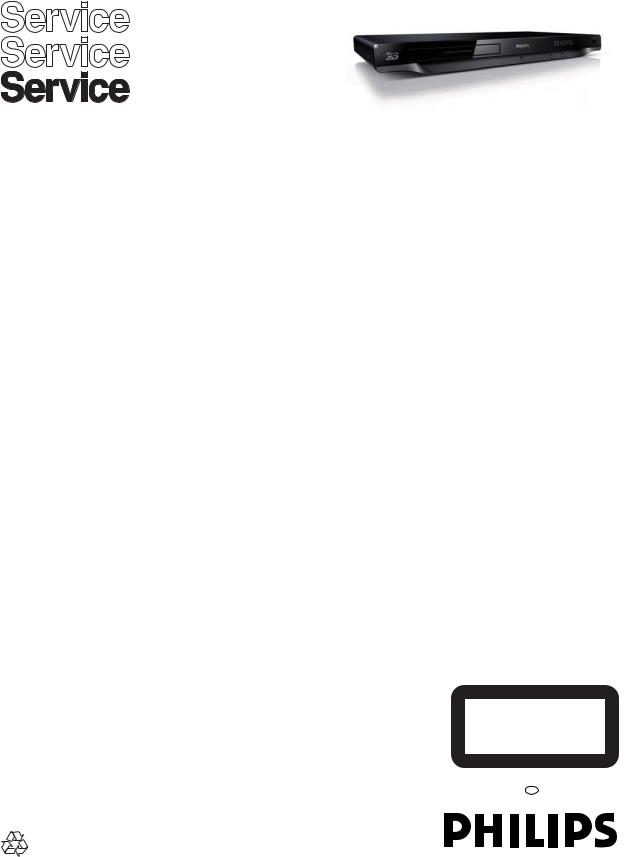
Blu-ray Disc Player |
BDP5200/12/05/51/98/55/K93/X78 |
|
|
|
|
|
|
|
|
|
|
|
|
|
|
|
|
|
|
|
|
|
|
|
TABLE OF CONTENTS
|
Page |
Location of PCB Boards & version variation & repair scenario matrix |
..................... 1-1 |
Production Specifications ............................................................................................... |
1-2 |
Remote control ............................................................................................................... |
1-3 |
Brife guide ...................................................................................................................... |
1-4 |
Safety Instruction, Warning & Notes............................................................................... |
1- 9 |
Mechanical and Dismantling Instructions ....................................................................... |
2-1 |
Software Version & Upgrades......................................................................................... |
3-1 |
Trouble Shooting Chart ..................................................................................................... |
4-1 |
Set Block & Wiring Diagrams ............................................................................ |
5-1 |
Electrical Diagrams and PCB layouts ................................................................ |
6-1 |
Set Mechanical Exploded view ....................................................................................... |
7-1 |
Revision List ................................................................................................................... |
8-1 |
© Copyright 2010 Philips Consumer Electronics B.V. Eindhoven, The Netherlands
All rights reserved. No part of this publication may be reproduced, stored in a retrieval system or transmitted, in any form or by any means, electronic, mechanical, photocopying, or otherwise without the prior permission of Philips.
CLASS 1
LASER PRODUCT
Published by Helen-RY 1116 Service Audio Printed in The Netherlands Subject to modification |
©313978535553 |
GB |
Version 1.3

1-1
LOCATION OF PCB BOARDS
MAIN BOARD |
|
AV BOARD |
|
|
|
POWER BOARD
LOADER
FE BOARD |
KE BOARD |
|
|
FRONT CABINET |
|
Version Variation |
|
|
|
|
|
|
|
|
|
|
|
|
|
||||
Type/Versions |
|
|
|
|
|
|
BDP5200 |
|
|
|
|
||||||
|
|
|
|
|
|
|
|
|
|
|
|||||||
|
|
|
|
|
|
|
|
|
|
|
|
|
|
|
|
|
|
Features |
|
|
/12 |
/05 |
/51 |
|
/98 |
|
/55 |
|
K93 |
X/78 |
|
||||
|
|
|
|
|
|
|
|
|
|
|
|
|
|
|
|
|
|
Power supply rating:220-240V ,60Hz |
|
|
X |
|
|
X |
|
|
|
|
|
|
|
|
|
||
|
|
|
|
|
|
|
|
|
|
|
|
|
|
|
|
|
|
Power supply rating:230-240V ,60Hz |
|
|
|
|
X |
|
|
|
|
|
|
|
|
|
|
||
|
|
|
|
|
|
|
|
|
|
|
|
|
|
|
|
|
|
Power supply rating:110-240V ,50Hz,60Hz |
|
|
|
|
X |
|
|
X |
|
X |
X |
|
|||||
|
|
|
|
|
|
|
|
|
|
|
|
|
|||||
|
|
|
|
|
|
|
|
|
|
|
|
|
|
|
|
|
|
Power consumption:18W |
|
|
X |
|
X |
|
X |
|
X |
|
|
X |
|
X |
X |
|
|
|
|
|
|
|
|
|
|
|
|
|
|
|
|
|
|
|
|
Repair Scenario Matrix |
|
|
|
|
|
|
|
|
|
|
|
|
|
|
|||
|
|
|
|
|
|
|
|
||||||||||
|
|
|
|
|
|
|
|
|
|
|
|
|
|
|
|
|
|
Type/Versions |
|
|
|
|
|
BDP5200 |
|
|
|
|
|
|
|
||||
|
|
|
|
|
|
|
|
|
|
|
|
|
|||||
|
|
|
|
|
|
|
|
|
|
|
|
|
|
|
|||
Board in used |
/12 |
|
/05 |
|
/51 |
|
/98 |
|
|
/55 |
|
K93 |
X/78 |
|
|||
Main Board |
Bd |
|
Bd |
|
Bd |
|
Bd |
|
|
|
Bd |
|
Bd |
Bd |
|
||
|
|
|
|
|
|
|
|
|
|
|
|
|
|
|
|
||
Power Board |
Bd |
|
Bd |
|
Bd |
|
Bd |
|
|
|
Bd |
|
Bd |
Bd |
|
||
|
|
|
|
|
|
|
|
|
|
|
|
|
|
|
|
||
AV Board |
Bd |
|
Bd |
|
Bd |
|
Bd |
|
|
|
Bd |
|
Bd |
Bd |
|
||
|
|
|
|
|
|
|
|
|
|
|
|
|
|
|
|
||
Loader |
Bd |
|
Bd |
|
Bd |
|
Bd |
|
|
|
Bd |
|
Bd |
Bd |
|
||
|
|
|
|
|
|
|
|
|
|
|
|
|
|
|
|
|
|
*Bd:Board Level Replacement |
|
|
|
|
|
|
|
|
|
|
|
|
|
|
|||
*C:Component Level Repair |
|
|
|
|
|
|
|
|
|
|
|
|
|
|
|||

1-2
BDP5200/12/05/51/98/55/K93/X78
Product Specifications
 Note
Note
6SHFLÀFDWLRQV DUH VXEMHFW WR FKDQJH ZLWKRXW QRWLFH
Region code
This player can play discs with the following region codes.
DVD |
Blu-ray |
Countries |
|
|
Europe, United Kingdom |
|
B |
|
Playable media
BD-Video, BD 3D
DVD-Video, DVD+R/+RW, DVD-R/-RW,
DVD+R/-R DL (Dual Layer)
VCD/SVCD
$XGLR &' &' 5 &' 5: 03 PHGLD
WMA media, JPEG files,
DivX (Ultra)/DivX Plus HD media, MKV mediaUSB storage device
File format
Video: .avi, .divx, .mp4, .mkv, .wmvAudio: .mp3, .wma, .wav
Picture: .jpg, .gif, .png
Video
Signal system: PAL / NTSC
Composite video output: 1 Vp-p (75 ohm)
HDMI output 480p, 576p, 720p, 1080i, 1080p,
1080p24
Audio
2 Channel analog output
Audio Front L&R : 2 Vrms (> 1 kohm)Digital output: 0.5 Vp-p (75 ohm)
CoaxialHDMI output
Sampling frequency:
MP3: 32 kHz, 44.1 kHz, 48 kHzWMA: 44.1 kHz, 48 kHz
Constant bit rate:
MP3: 112 kbps - 320 kpbsWMA: 48 kpbs - 192 kpbs
USB
Compatibility: Hi-Speed USB (2.0)
Class support: USB Mass Storage ClassFile system: FAT16, FAT32
Support HDD (a portable hard drive disc): an external power source may be needed.
Main unit
BDP5200/12/51:
Power supply rating: AC 220-240V~, 50 Hz
BDP5200/05:
Power supply rating: AC 230-240V~, 50 Hz
BDP5200/98/55/K93/X78:
Power supply rating: AC 110-240V~, 50 Hz , 60Hz
Power consumption: 18 W
Power consumption in standby mode: < 0.18 WDimensions (w x h x d): 435 x 42 x 208.5 (mm)Net Weight: 1.65 kg
Accessories supplied
Remote control and batteriesUser manual
CD-ROM built in multi-lingual user manua
(Continental Europe only)
/DVHU 6SHFLÀFDWLRQ
Laser Type (Diode): AlGaInN (BD), AlGaInP
(DVD/CD)
Wave length: 400 ~ 410nm (BD), 650 ~ 663nm
(DVD), 770 ~80 0nm (CD)
Output power (Max ratings): 20mW (BD), 7mW
(DVD), 7mW (CD)
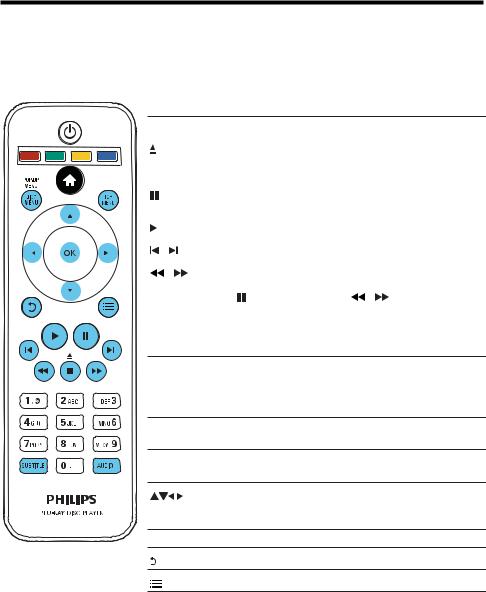
1-3
Remote Control
During play, press the following buttons to control.
Button |
Action |
|
|
||
/ |
|
|
Stop play. |
|
|
|
|
|
|
||
|
|
Press and hold (more than 4 seconds) to open or close |
|||
|
|
|
|||
|
|
|
the disc compartment. |
|
|
|
|
|
Pause play. |
|
|
|
|
|
Press repeatedly to slow forward frame by frame. |
||
|
|
|
Start or resume play. |
|
|
|
|
|
|
||
/ |
|
6NLS WR WKH SUHYLRXV RU QH[W WUDFN FKDSWHU RU ÀOH |
|||
|
|
|
|
||
/ |
|
Fast backward or forward. |
|
|
|
|
Press repeatedly to change the search speed. |
||||
|
|
|
|||
|
|
|
Press once, and then press |
/ |
to slow backward |
|
|
|
or forward. |
|
|
AUDIO |
Select an audio language or channel. |
|
|||
SUBTITLE Select a subtitle language.
DISC Access or exit the disc menu.
MENU /
POP-UP
MENU
TOP Access the main menu of a video disc.
MENU
Color Select tasks or options for Blu-ray discs. buttons
Navigate the menus.
Press  to rotate a picture clockwise or counterclockwise during slideshow.
to rotate a picture clockwise or counterclockwise during slideshow.
OK &RQÀUP D VHOHFWLRQ RU HQWU\
Return to a previous display menu.
Access more options during play.
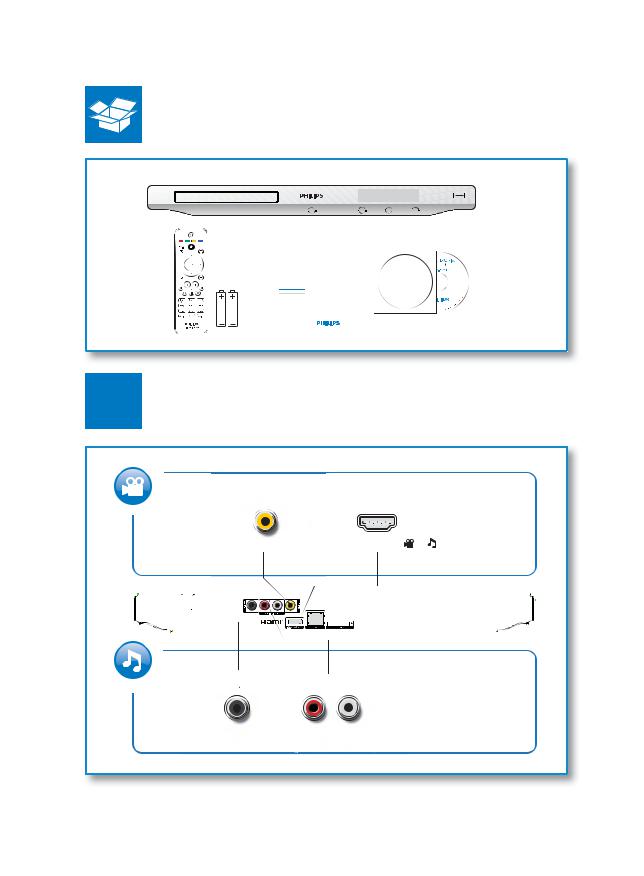
1-4
 Brife Guide
Brife Guide
Register your product and get support at
www.philips.com/welcome
BDP5200
BDP5200
PC & Mac
EN User manual
1
|
|
|
|
VIDEO |
|
|
|
|
HDMI ( |
|
|
|
) |
|
|||||
|
|
|
|
|
|
|
|
|
|||||||||||
|
|
|
|
|
|
|
|
|
|
|
|
|
|
|
|
|
|
|
|
|
|
|
|
|
|
|
|
|
|
|
|
|
|
|
|
|
|
|
|
|
|
|
|
|
|
|
|
|
|
|
|
|
|
|
|
|
|
|
|
|
|
|
|
|
|
|
|
|
|
|
|
|
|
|
|
|
|
|
|
|
|
|
|
|
|
|
|
|
|
|
|
|
|
|
|
|
|
|
|
|
|
|
|
|
|
|
|
|
|
|
|
|
|
|
|
|
|
|
|
|
|
|
|
|
|
|
|
|
|
|
|
|
|
|
|
|
|
|
|
|
|
|
|
|
|
|
|
|
|
|
|
|
|
|
|
|
|
|
|
COAXIAL A UDIO LINE OUT
UDIO LINE OUT

2 
1 HDMI
1-5
HDMI {VIDEO {COAXIAL {AUDIO LINE OUT
2 VIDEO+AUDIO LINE OUT
{HDMI VIDEO {COAXIAL AUDIO LINE OUT
AUDIO LINE OUT
VIDEO


1-6
3 COAXIAL
{HDMI {VIDEO COAXIAL {AUDIO LINE OUT
COAXIAL 
4 AUDIO LINE OUT
{HDMI {VIDEO {COAXIAL AUDIO LINE OUT
AUDIO LINE OUT
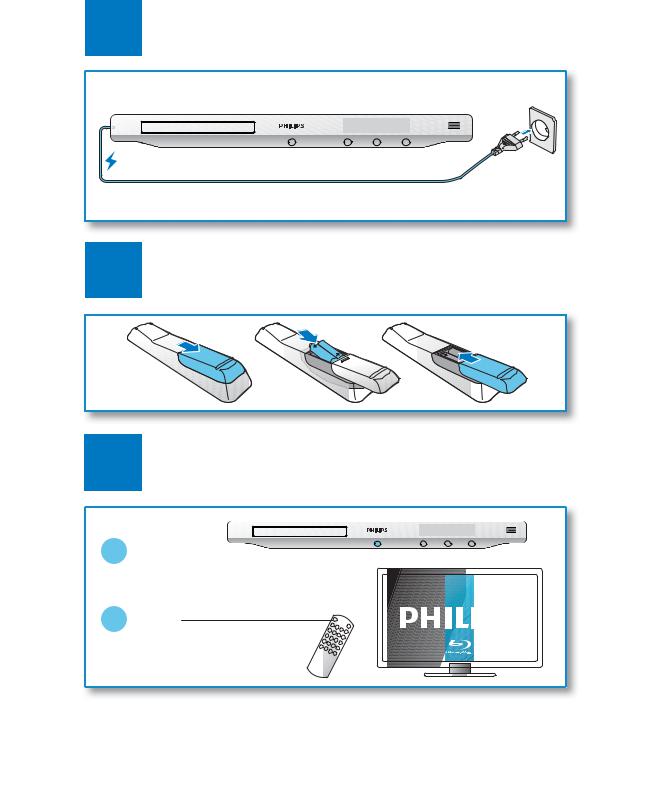
1-7
3
4
5
1 

2 
SOURCE
TV
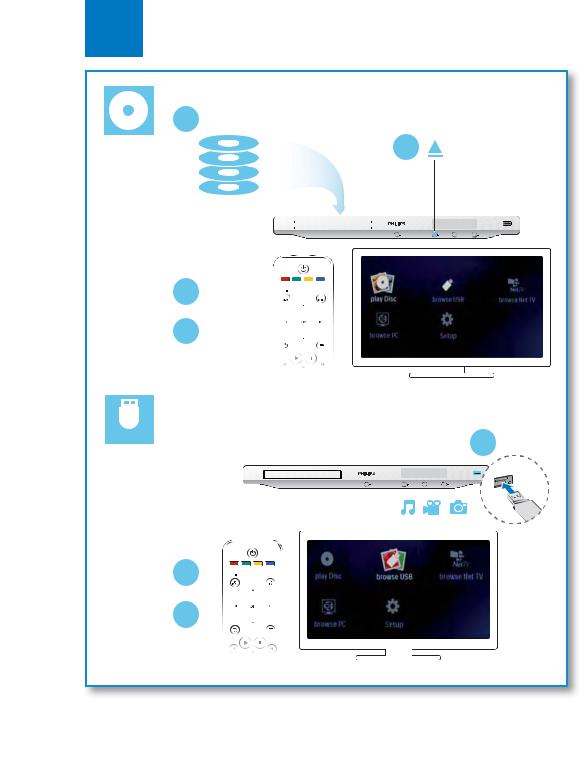
1-8
6
2
BD/BD 3D |
1 |
||
DVD/VCD/CD |
|||
|
|||
DivX Plus HD/MKV |
|
||
MP3 / JPEG |
|
||
|
|
|
|
|
|
|
|
3 


 4
4 
USB
1
2 
 3
3 
1-9
2.Safety Instructions, Warnings, Notes, and Abbreviation List
Index of this chapter:
2.1 Safety Instructions
2.2 Warnings
2.3 Notes
2.4 Abbreviation List
2.1Safety Instructions
Safety regulations require the following during a repair:
•Connect the set to the Mains/AC Power via an isolation transformer (> 800 VA).
•Replace safety components, indicated by the symbol  , only by components identical to the original ones. Any other component substitution (other than original type) may increase risk of fire or electrical shock hazard.
, only by components identical to the original ones. Any other component substitution (other than original type) may increase risk of fire or electrical shock hazard.
Safety regulations require that after a repair, the set must be returned in its original condition. Pay in particular attention to the following points:
•Route the wire trees correctly and fix them with the mounted cable clamps.
•Check the insulation of the Mains/AC Power lead for external damage.
•Check the strain relief of the Mains/AC Power cord for proper function.
•Check the electrical DC resistance between the Mains/AC Power plug and the secondary side (only for sets that have a Mains/AC Power isolated power supply):
1.Unplug the Mains/AC Power cord and connect a wire between the two pins of the Mains/AC Power plug.
2.Set the Mains/AC Power switch to the “on” position (keep the Mains/AC Power cord unplugged!).
3.Measure the resistance value between the pins of the Mains/AC Power plug and the metal shielding of the tuner or the aerial connection on the set. The reading should be between 4.5 M: and 12 M:.
4.Switch “off” the set, and remove the wire between the two pins of the Mains/AC Power plug.
•Check the cabinet for defects, to prevent touching of any inner parts by the customer.
•Where necessary, measure the waveforms and voltages with ( ) and without (
) and without ( ) aerial signal. Measure the
) aerial signal. Measure the
voltages in the power supply section both in normal operation ( ) and in stand-by (
) and in stand-by ( ). These values are indicated by means of the appropriate symbols.
). These values are indicated by means of the appropriate symbols.
2.3.2Schematic Notes
•All resistor values are in ohms, and the value multiplier is often used to indicate the decimal point location (e.g. 2K2 indicates 2.2 k:).
•Resistor values with no multiplier may be indicated with
either an “E” or an “R” (e.g. 220E or 220R indicates 220 :).
• All capacitor values are given in micro-farads (P u 10-6), nano-farads (n u 10-9), or pico-farads (p u 10-12).
•Capacitor values may also use the value multiplier as the decimal point indication (e.g. 2p2 indicates 2.2 pF).
•An “asterisk” (*) indicates component usage varies. Refer to the diversity tables for the correct values.
•The correct component values are listed in the Spare Parts List. Therefore, always check this list when there is any doubt.
2.3.3BGA (Ball Grid Array) ICs
Introduction
For more information on how to handle BGA devices, visit this URL: www.atyourservice.ce.philips.com (needs subscription,
not available for all regions). After login, select “Magazine”, then go to “Repair downloads”. Here you will find Information on how to deal with BGA-ICs.
BGA Temperature Profiles
For BGA-ICs, you must use the correct temperature-profile,
which is coupled to the 12NC. For an overview of these profiles, visit the website www.atyourservice.ce.philips.com (needs
subscription, but is not available for all regions)
You will find this and more technical information within the “Magazine”, chapter “Repair downloads”.
For additional questions please contact your local repair help desk.
2.2Warnings
•All ICs and many other semiconductors are susceptible to electrostatic discharges (ESD  ). Careless handling during repair can reduce life drastically. Make sure that,
). Careless handling during repair can reduce life drastically. Make sure that,
during repair, you are connected with the same potential as the mass of the set by a wristband with resistance. Keep components and tools also at this same potential.
•Be careful during measurements in the high voltage section.
•Never replace modules or other components while the unit is switched “on”.
•When you align the set, use plastic rather than metal tools. This will prevent any short circuits and the danger of a circuit becoming unstable.
2.3Notes
2.3.1General
•Measure the voltages and waveforms with regard to the chassis (= tuner) ground ( ), or hot ground (
), or hot ground ( ), depending on the tested area of circuitry. The voltages and waveforms shown in the diagrams are indicative. Measure them in the Service Default Mode (see chapter 5) with a colour bar signal and stereo sound (L: 3 kHz, R: 1 kHz unless stated otherwise) and picture carrier at 475.25 MHz for PAL, or 61.25 MHz for NTSC (channel 3).
), depending on the tested area of circuitry. The voltages and waveforms shown in the diagrams are indicative. Measure them in the Service Default Mode (see chapter 5) with a colour bar signal and stereo sound (L: 3 kHz, R: 1 kHz unless stated otherwise) and picture carrier at 475.25 MHz for PAL, or 61.25 MHz for NTSC (channel 3).
2.3.4Lead-free Soldering
Due to lead-free technology some rules have to be respected by the workshop during a repair:
•Use only lead-free soldering tin Philips SAC305 with order code 0622 149 00106. If lead-free solder paste is required, please contact the manufacturer of your soldering equipment. In general, use of solder paste within workshops should be avoided because paste is not easy to store and to handle.
•Use only adequate solder tools applicable for lead-free soldering tin. The solder tool must be able:
–To reach a solder-tip temperature of at least 400°C.
–To stabilize the adjusted temperature at the solder-tip.
–To exchange solder-tips for different applications.
•Adjust your solder tool so that a temperature of around 360°C - 380°C is reached and stabilized at the solder joint. Heating time of the solder-joint should not exceed ~ 4 sec. Avoid temperatures above 400°C, otherwise wear-out of tips will increase drastically and flux-fluid will be destroyed. To avoid wear-out of tips, switch “off” unused equipment or reduce heat.
•Mix of lead-free soldering tin/parts with leaded soldering tin/parts is possible but PHILIPS recommends strongly to avoid mixed regimes. If this cannot be avoided, carefully clear the solder-joint from old tin and re-solder with new tin.
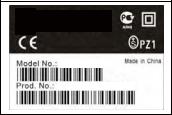
1 - 10
Safety Instructions, Warnings, Notes, and Abbreviation List
2.3.5Alternative BOM identification
It should be noted that on the European Service website, “Alternative BOM” is referred to as “Design variant”.
The third digit in the serial number (example:
KX2B0835000001) indicates the number of the alternative B.O.M. (Bill Of Materials) that has been used for producing the specific AV set. In general, it is possible that the same AV model on the market is produced with e.g. two different types of display, coming from two different suppliers. This
will then result in sets which have the same CTN (Commercial Type Number; e.g. MCM394/12) but which have a different B.O.M. number.
Also, it is possible that same model on the market is produced with two production centers, however their partslist is the same. In such case, no alternative B.O.M. will be created.
By looking at the third digit of the serial number, one can identify which B.O.M. is used for the set he is working with. If the third digit of the serial number contains the number “1” (example: KX1B033500001), then the set has been
manufactured according to B.O.M. number 1. If the third digit is a “2” (example: KX2B0335000001), then the set has been produced according to B.O.M. no. 2. This is important for ordering the correct spare parts!
For the third digit, the numbers 1...9 and the characters A...Z can be used, so in total: 9 plus 26= 35 different B.O.M.s can be indicated by the third digit of the serial number.
Identification: The bottom line of a type plate gives a 14-digit serial number. Digits 1 and 2 refer to the production centre (e.g. LM is Arts), digit 3 refers to the B.O.M. code, digit 4 refers
to the Service version change code, digits 5 and 6 refer to the production year, and digits 7 and 8 refer to production week (in example below it is 2008 week 50). The 6 last digits contain the serial number.
Model FWM572/12 220-230 50Hz 60W
FWM572/12
LM1A0850005644
Figure 2-1 Serial number (example)
2.3.6Module Level Repair (MLR) or Component Level Repair (CLR)
If a board is defective, consult your repair procedure to decide if the board has to be exchanged or if it should be repaired on component level.
If your repair procedure says the board should be exchanged completely, do not solder on the defective board. Otherwise, it cannot be returned to the O.E.M. supplier for back charging!
2.3.7Practical Service Precautions
•It makes sense to avoid exposure to electrical shock.
While some sources are expected to have a possible dangerous impact, others of quite high potential are of limited current and are sometimes held in less regard.
•Always respect voltages. While some may not be dangerous in themselves, they can cause unexpected reactions that are best avoided. Before reaching into a powered TV set, it is best to test the high voltage insulation. It is easy to do, and is a good service precaution.
2.4Abbreviation List
0/6/12 |
SCART switch control signal on A/V |
|
board. 0 = loop through (AUX to TV), |
|
6 = play 16 : 9 format, 12 = play 4 : 3 |
|
format |
2DNR |
Spatial (2D) Noise Reduction |
3DNR |
Temporal (3D) Noise Reduction |
AARA |
Automatic Aspect Ratio Adaptation: |
|
algorithm that adapts aspect ratio to |
|
remove horizontal black bars; keeps |
|
the original aspect ratio |
ACI |
Automatic Channel Installation: |
|
algorithm that installs TV channels |
|
directly from a cable network by |
|
means of a predefined TXT page |
ADC |
Analogue to Digital Converter |
AFC |
Automatic Frequency Control: control |
|
signal used to tune to the correct |
|
frequency |
AGC |
Automatic Gain Control: algorithm that |
|
controls the video input of the feature |
|
box |
AM |
Amplitude Modulation |
ANR |
Automatic Noise Reduction: one of the |
|
algorithms of Auto TV |
AP |
Asia Pacific |
AR |
Aspect Ratio: 4 by 3 or 16 by 9 |
ASF |
Auto Screen Fit: algorithm that adapts |
|
aspect ratio to remove horizontal black |
|
bars without discarding video |
|
information |
ATSC |
Advanced Television Systems |
|
Committee, the digital TV standard in |
|
the USA |
ATV |
See Auto TV |
Auto TV |
A hardware and software control |
|
system that measures picture content, |
|
and adapts image parameters in a |
|
dynamic way |
AV |
External Audio Video |
AVC |
Audio Video Controller |
AVIP |
Audio Video Input Processor |
B/G |
Monochrome TV system. Sound |
|
carrier distance is 5.5 MHz |
BLR |
Board-Level Repair |
BTSC |
Broadcast Television Standard |
|
Committee. Multiplex FM stereo sound |
|
system, originating from the USA and |
|
used e.g. in LATAM and AP-NTSC |
|
countries |
B-TXT |
Blue TeleteXT |
CCentre channel (audio)
CEC |
Consumer Electronics Control bus: |
|
remote control bus on HDMI |
|
connections |
CL |
Constant Level: audio output to |
|
connect with an external amplifier |
CLR |
Component Level Repair |
COLUMBUS |
COlor LUMinance Baseband |
|
Universal Sub-system |
ComPair |
Computer aided rePair |
CP |
Connected Planet / Copy Protection |
CSM |
Customer Service Mode |
CTI |
Color Transient Improvement: |
|
manipulates steepness of chroma |
|
transients |
CVBS |
Composite Video Blanking and |
|
Synchronization |
DAC |
Digital to Analogue Converter |
DBE |
Dynamic Bass Enhancement: extra |
|
low frequency amplification |
DDC |
See “E-DDC” |
1 - 11
Safety Instructions, Warnings, Notes, and Abbreviation List
D/K |
Monochrome TV system. Sound |
|
lines. The fields are written in “pairs”, |
|
carrier distance is 6.5 MHz |
|
causing line flicker. |
DFI |
Dynamic Frame Insertion |
IR |
Infra Red |
DFU |
Directions For Use: owner's manual |
IRQ |
Interrupt Request |
DMR |
Digital Media Reader: card reader |
ITU-656 |
The ITU Radio communication Sector |
DMSD |
Digital Multi Standard Decoding |
|
(ITU-R) is a standards body |
DNM |
Digital Natural Motion |
|
subcommittee of the International |
DNR |
Digital Noise Reduction: noise |
|
Telecommunication Union relating to |
|
reduction feature of the set |
|
radio communication. ITU-656 (a.k.a. |
DRAM |
Dynamic RAM |
|
SDI), is a digitized video format used |
DRM |
Digital Rights Management |
|
for broadcast grade video. |
DSP |
Digital Signal Processing |
|
Uncompressed digital component or |
DST |
Dealer Service Tool: special remote |
|
digital composite signals can be used. |
|
control designed for service |
|
The SDI signal is self-synchronizing, |
|
technicians |
|
uses 8 bit or 10 bit data words, and has |
DTCP |
Digital Transmission Content |
|
a maximum data rate of 270 Mbit/s, |
|
Protection; A protocol for protecting |
|
with a minimum bandwidth of 135 |
|
digital audio/video content that is |
|
MHz. |
|
traversing a high speed serial bus, |
ITV |
Institutional TeleVision; TV sets for |
|
such as IEEE-1394 |
|
hotels, hospitals etc. |
DVB-C |
Digital Video Broadcast - Cable |
JOP |
Jaguar Output Processor |
DVB-T |
Digital Video Broadcast - Terrestrial |
LS |
Last Status; The settings last chosen |
DVD |
Digital Versatile Disc |
|
by the customer and read and stored |
DVI(-d) |
Digital Visual Interface (d= digital only) |
|
in RAM or in the NVM. They are called |
E-DDC |
Enhanced Display Data Channel |
|
at start-up of the set to configure it |
|
(VESA standard for communication |
|
according to the customer's |
|
channel and display). Using E-DDC, |
|
preferences |
|
the video source can read the EDID |
LATAM |
Latin America |
|
information form the display. |
LCD |
Liquid Crystal Display |
EDID |
Extended Display Identification Data |
LED |
Light Emitting Diode |
|
(VESA standard) |
L/L' |
Monochrome TV system. Sound |
EEPROM |
Electrically Erasable and |
|
carrier distance is 6.5 MHz. L' is Band |
|
Programmable Read Only Memory |
|
I, L is all bands except for Band I |
EMI |
Electro Magnetic Interference |
LORE |
LOcal REgression approximation |
EPLD |
Erasable Programmable Logic Device |
|
noise reduction |
EU |
Europe |
LPL |
LG.Philips LCD (supplier) |
EXT |
EXTernal (source), entering the set by |
LS |
Loudspeaker |
|
SCART or by cinches (jacks) |
LVDS |
Low Voltage Differential Signalling |
FBL |
Fast BLanking: DC signal |
Mbps |
Mega bits per second |
|
accompanying RGB signals |
M/N |
Monochrome TV system. Sound |
FDS |
Full Dual Screen (same as FDW) |
|
carrier distance is 4.5 MHz |
FDW |
Full Dual Window (same as FDS) |
MIPS |
Microprocessor without Interlocked |
FLASH |
FLASH memory |
|
Pipeline-Stages; A RISC-based |
FM |
Field Memory or Frequency |
|
microprocessor |
|
Modulation |
MOP |
Matrix Output Processor |
FPGA |
Field-Programmable Gate Array |
MOSFET |
Metal Oxide Silicon Field Effect |
FTV |
Flat TeleVision |
|
Transistor, switching device |
Gb/s |
Giga bits per second |
MPEG |
Motion Pictures Experts Group |
G-TXT |
Green TeleteXT |
MPIF |
Multi Platform InterFace |
H |
H_sync to the module |
MUTE |
MUTE Line |
HD |
High Definition |
NC |
Not Connected |
HDD |
Hard Disk Drive |
NICAM |
Near Instantaneous Compounded |
HDCP |
High-bandwidth Digital Content |
|
Audio Multiplexing. This is a digital |
|
Protection: A “key” encoded into the |
|
sound system, mainly used in Europe. |
|
HDMI/DVI signal that prevents video |
NTC |
Negative Temperature Coefficient, |
|
data piracy. If a source is HDCP coded |
|
non-linear resistor |
|
and connected via HDMI/DVI without |
NTSC |
National Television Standard |
|
the proper HDCP decoding, the |
|
Committee. Color system mainly used |
|
picture is put into a “snow vision” mode |
|
in North America and Japan. Color |
|
or changed to a low resolution. For |
|
carrier NTSC M/N= 3.579545 MHz, |
|
normal content distribution the source |
|
NTSC 4.43= 4.433619 MHz (this is a |
|
and the display device must be |
|
VCR norm, it is not transmitted off-air) |
|
enabled for HDCP “software key” |
NVM |
Non-Volatile Memory: IC containing |
|
decoding. |
|
TV related data such as alignments |
HDMI |
High Definition Multimedia Interface |
O/C |
Open Circuit |
HP |
HeadPhone |
OSD |
On Screen Display |
I |
Monochrome TV system. Sound |
OTC |
On screen display Teletext and |
I2C |
carrier distance is 6.0 MHz |
|
Control; also called Artistic (SAA5800) |
Inter IC bus |
P50 |
Project 50: communication protocol |
|
I2D |
Inter IC Data bus |
|
between TV and peripherals |
I2S |
Inter IC Sound bus |
PAL |
Phase Alternating Line. Color system |
IF |
Intermediate Frequency |
|
mainly used in West Europe (color |
Interlaced |
Scan mode where two fields are used |
|
carrier= 4.433619 MHz) and South |
|
to form one frame. Each field contains |
|
America (color carrier PAL M= |
|
half the number of the total amount of |
|
|
